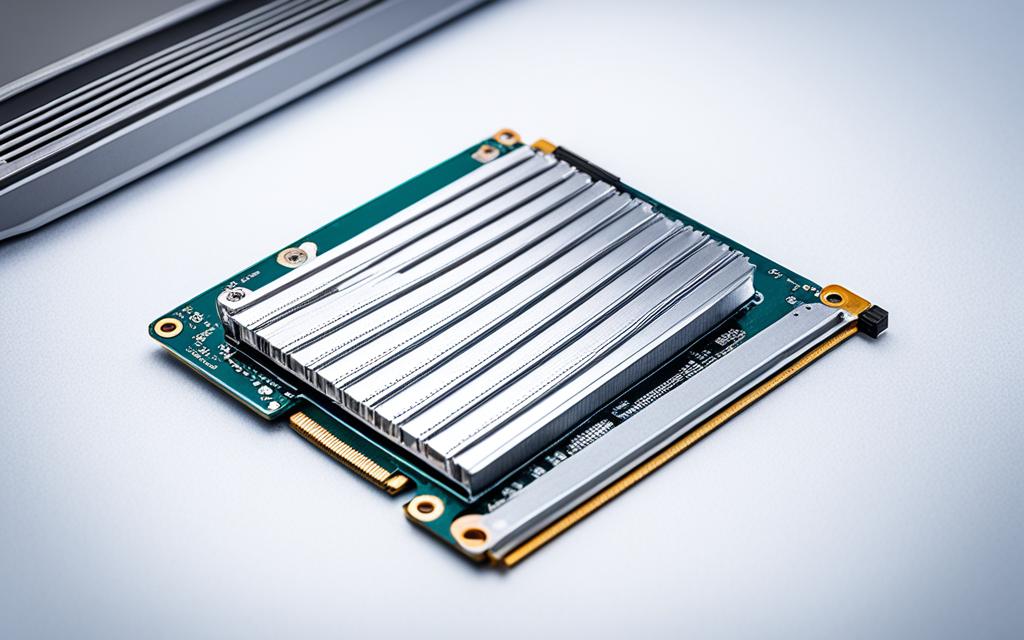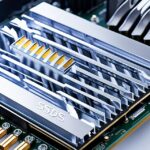Table of Contents
Solid-state drives (SSDs) are now a big part of modern computers, especially NVMe ones. People often wonder if SSDs need a heat sink to keep them from getting too hot. Heat can cause an SSD to slow down, lose data, or even break down, so keeping it cool is key. SSDs can get hotter than 80°C when they’re working hard. This makes finding the right way to cool them very important.
This piece will look at how SSDs are made, the heat they create, and how to cool them down. We’ll discuss if you need an extra heat sink. By the end, you’ll know how to manage heat for NVMe SSDs depending on your computer and what you need it for. For a deeper look, check out this article1.
Key Takeaways
- Heat sinks play a key role in keeping SSD temperatures down, mainly when moving lots of data.
- SSDs can heat up over 80°C, which shows the need for good cooling methods.
- Getting too hot can hurt the SSD’s performance and make data less reliable.
- It’s crucial to keep an eye on your SSD’s temperature for its best performance and long life.
- For M.2 NVMe SSDs, adding an extra heatsink is often a good idea.
- Smaller SSD models are getting more popular because they offer more choices for storing data.
- If you’re using a PS5, getting an SSD with a heatsink can stop it from overheating and make it run better.
Understanding SSDs and Their Components
Solid State Drives (SSDs) have become key for modern computers, mixing speed with efficiency. To fully use these devices, knowing the SSD components and their operation is key. This knowledge ensures they keep delivering top speeds.
What Makes Up an SSD?
An SSD has several important parts that make it work. The controller chip is like a CPU, managing data movements. Next, the DRAM chip acts as a quick cache, speeding up data handling. Yet, the core of an SSD is its NAND flash memory chips. This is where all data is stored.
There are different NAND types – SLC, MLC, TLC, and QLC. Each type meets various speed and storage needs, affecting the SSD’s overall performance.
By upgrading a PC with an SSD, speed boosts drastically. Thus, choosing the right SSD parts is crucial for anyone looking to improve their system.
How SSDs Operate and Generate Heat
Knowing how SSDs work helps explain why they get hot. The NVMe setup is key here, enabling fast data access via parallel actions. SSDs with PCIe Gen4 tech almost double the speed of older models. This is thanks to their quick connections.
During heavy use, like gaming or video editing, these speeds cause a lot of heat. It’s vital to cool them properly to stop any slowdowns. Ideally, SSDs should stay between 0°C and 70°C2. Managing heat well is essential for keeping your SSD running smoothly, especially during lots of activity.
Why SSDs Heat Up During Use
It’s important to know why Solid State Drives (SSDs) get hot. They work harder when you’re using your computer a lot. This is because they’re doing many things at once, like moving big files or running heavy apps. These actions make the SSD’s inside parts work harder than usual.
Factors Contribiting to Increased Temperatures
One main reason SSDs get hot is because of the NVMe protocol. This technology makes SSDs work faster by handling data all at once. But, when they work fast, they also make more heat. For example, NVMe SSDs can get hotter than 80°C, but they work best under 70°C. So, keeping them cool is very important3. If they get too hot, they might slow down temporarily to cool off3.
Heat Management During Intensive Tasks
Heatsinks help keep SSDs from getting too warm. Most computers have a cooling spot for SSDs, but sometimes it’s not big enough. You can buy extra coolers, like the IceFLOE for $6.99, to help4. When you’re doing things like gaming or editing videos, good cooling is key. Otherwise, your SSD might not work as well5.
Signs Your SSD May Be Overheating
Knowing when your SSD is too hot is key to keeping your system running well. If it gets too warm, it can really slow down, affecting how your device works. You might notice this if your computer or files start acting up.
Performance Issues Caused by High Temperatures
If your SSD’s temperature goes above 70°C, it might start up slow, crash, or shut down without warning6. You might see apps freezing, especially if you’re doing a lot on your computer. Or, you could hear the cooling fans working overtime. That’s a sign they’re trying to lower the SSD’s temperature7.
Keeping your SSD too hot for too long can damage it permanently. This damage can mess up your files and make the SSD unreliable8. It’s really important to keep it cool to avoid these problems.
Tools for Monitoring SSD Temperature
It’s smart to keep an eye on how hot your SSD gets. You can use tools like Crucial’s Storage Executive and EaseUS Partition Master Free for checking temperature7. By monitoring your SSD’s warmth, you can avoid overheating. This helps your computer stay in good shape.
Do You Need a Heat Sink for SSD?
Understanding the SSD heat sink necessity is key for good storage function. Heat sinks are great for those doing heavy tasks. These include moving lots of data or using tough applications. With advances in SSDs and new PCIe 5.0 tech, knowing when to use a heat sink is more crucial.
When Is a Heat Sink Necessary?
Many SSDs today come with heat sinks, especially the ones made for heavy use. They can get quite hot due to their fast speed and large tasks. This is why helping them stay cool is important. Users have found that not using a heat sink with PCIe 5.0 SSDs can cause big problems. Without cooling, there could be errors or your drive might stop working, which can also harm other parts9. This shows how vital a good heat sink is for keeping high-performance SSDs working well.
When a Heat Sink May Not Be Required
However, not everyone needs a heat sink. If you use your computer for everyday tasks and it has good airflow, your SSD should be fine without extra cooling. There are also SSDs that don’t get very hot. So, they might not need a heat sink. Also, to keep prices low, some makers don’t add heat sinks to their drives10. In the end, whether you should get a heat sink depends on how you use your SSD and what its needs are.
Cooling Solutions for Your SSD
Keeping your SSD at the right temperature is key for its life span and speed. You can choose from two main ways to cool it down: passive and active cooling. Passive cooling uses things like heatsinks to let heat out naturally. This approach can lower heat by 10-15 degrees Celsius11, which is great for those wanting an easy setup. But, if you’re moving big files and the load is heavy, active cooling might work better. This method uses fans or liquid cooling to control the temperature.
Passive vs Active Cooling Methods
Passive cooling solutions, such as the Iceberg Thermal’s IceFLOE SSD heatsink, work well for daily tasks and are cheap at $6.994. If you’re into gaming or making videos, you might need something stronger like Thermalright’s HR-10 Pro. It has a built-in fan for better performance4. But, the Jiushark M.2-Three heatsink, known for keeping things cool, might need you to order it from abroad4. It’s wise to think about which method suits your needs best.
Overview of Built-in Cooling Solutions on Motherboards
Nowadays, many motherboards come with their own cooling tricks. They use heat spreaders or special designs to manage heat. About 45% of users prefer SSDs that already have heatsinks11. Since 70% of SSD problems come from getting too hot11, choosing the right cooling option is crucial. It’s not just about preference, but about making your drive last longer. Knowing your options helps you pick the best way to keep performance up and reliability strong. representation
FAQ
Is a heat sink necessary for my SSD?
A heat sink can help if you move a lot of data or run demanding apps. It might not be needed for everyday tasks. Good airflow in your system also lessens the need for one.
What components make up an SSD?
Three main parts form an SSD. There’s a controller chip for managing data, a DRAM chip that speeds up data transfer, and NAND flash memory chips for storing your data.
How do SSD components generate heat?
SSDs generate heat mainly when you’re gaming, transferring big files, or when there’s a lot going on at once. This is because all its parts are working harder.
What contributes to increased temperatures in SSDs?
High temperatures in SSDs come from doing a lot at once or moving large files. These actions put more stress on the SSD’s parts.
What are the signs that my SSD might be overheating?
Signs of an overheating SSD are slow apps and more noise from cooling fans. These suggest your SSD is too hot.
What tools can I use to monitor my SSD’s temperature?
You can use tools like Crucial’s Storage Executive and EaseUS Partition Master to keep an eye on your SSD’s temperature. They tell you if it’s getting too hot.
When should I consider using a heat sink for my SSD?
Consider a heat sink if you often game or do big data transfers. It keeps the SSD cool, ensuring it runs well.
Are there conditions when a heat sink may not be required?
You might not need a heat sink if your system is well-ventilated. Or if your motherboard already cools the SSD well.
What are the different cooling solutions for SSDs?
SSD cooling can be passive, like heat sinks that naturally dissipate heat. Or active, using fans or liquid to cool the SSD.
What built-in cooling solutions might modern motherboards offer?
Modern motherboards may have cooling like heat spreaders or special designs. These keep SSDs cool without extra equipment.
Source Links
- https://www.easeus.com/computer-instruction/do-i-need-a-heatsink-for-my-m2-ssd.html – Do I Need a Heatsink for My M.2 SSD [2024 Full Guide]
- https://www.corsair.com/us/en/explorer/diy-builder/storage/is-cooling-necessary-for-an-m2-nvme-ssd/ – Do you need to cool your M.2 NVMe SSD?
- https://www.minitool.com/lib/m2-heatsink.html – What Is M.2 Heatsink? Do NVMe SSDs Need Heatsinks? – MiniTool
- https://wccftech.com/review/ssd-heatsink-guide-the-best-cooling-options-for-your-nvme-drive/ – SSD Heatsink Guide: The best cooling options for your NVMe drive
- https://blog.westerndigital.com/ssd-heatsink-hot-storage-cool-data-m2/ – SSD Heatsink: Hot Data, Cool Storage
- https://www.easeus.com/computer-instruction/can-ssd-overheat.html – SSD Overheating? Check Full Explanation and Reasons!
- https://scot-comp.co.uk/addressing-laptop-m-2-ssd-overheating/ – Addressing Laptop M.2 SSD Overheating
- https://www.techtarget.com/searchstorage/post/Understand-SSD-overheating-and-what-to-do-about-it – Understand SSD overheating and what to do about it | TechTarget
- https://www.xda-developers.com/pcie-5-ssd-need-heatsink/ – Do I need a heatsink for PCIe 5.0 SSDs?
- https://www.makeuseof.com/what-is-m2-nvme-ssd-heatsink/ – What Is an M.2 NVMe SSD Heatsink?
- https://rog-forum.asus.com/t5/amd-500-400-series/do-you-use-any-additional-cooling-for-m-2-ssd/td-p/774204 – Do you use any additional cooling for M.2 SSD?








